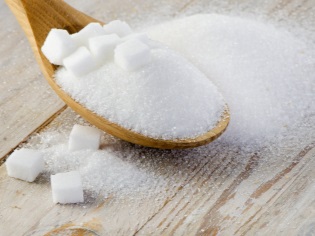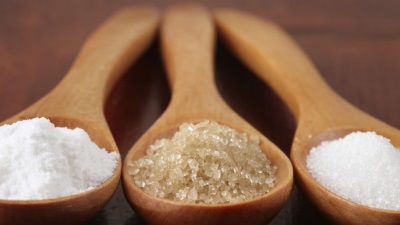At what age can you give sugar to a child?
There are quite a lot of talk about the dangers of sugar these days. The fact that white sugar should not be given to children can be heard from pediatricians, and from dentists, and from supporters of a healthy diet. But does it really bring harm to the human body or does this product have beneficial properties? And at what age is it permissible to include it and sweet foods in the children's menu?
Benefit
For a child, sugar is primarily a source of fast carbohydrates, which give the child’s body energy for active movements and mental processes. Its use activates many processes in the body of the child, as well as a positive effect on the brain.
In addition, sugar affects the mood of the child, as the sweet taste of food brings pleasure. A good property is also its inhibitory effect on many harmful microorganisms, so that it is used as a natural preservative.
Harm
- Note the negative impact on the intestinal microflora. Excessive sweets inhibits beneficial bacteria and activates fermentation processes, which can cause stool disorders and flatulence.
- High calorific value causes the risk of weight gainassociated with excessive use of such a product. Sugar, which is not spent by a child on activity, is stored in the body, being deposited in fat reserves.
- Too much sugar in the child’s diet is bad for his nervous system. Children who eat a lot of sweets are more excitable and irritable. Their behavior is hysterical, and sometimes with manifestations of aggression.
- There is a negative impact on the absorption of vitamins, as well as on mineral metabolism. In particular, the consumption of such a product contributes to the leaching of calcium and provokes a shortage of B-group vitamins.
- Its use is one of the factors provoking the development of caries. Sweet drinking can cause bottle caries, because of which the baby loses baby teeth early, which can lead to improper bite.
- After eating sweets The child’s immune protection becomes weakened for a while.
- Kids quickly get used to the sweet taste and may refuse dishes to which it is not added.For example, they drink weak tea with sugar and compote, discarding ordinary water.
- Elevated blood sugar may provoke food allergies or its aggravation.
The famous pediatrician Dr. E. Komarovsky tells about the harm:
From what age can be given
Most pediatricians do not recommend adding sugar to baby’s dishes under one year old. They are sure that it is enough for nursing babies to get lactose from mother's milk or adapted mixture. At the age of 6 months in the diet of infants, natural sources of fructose and glucose appear in the form of fruit purees, and complex carbohydrates are produced from cereals and vegetables.
Familiarity with sugar doctors advise to delay as much as possible, but after a year it is permissible to add it to baby food in small quantities. 6 g of sugar per day is considered to be the norm for children under 3 years old, and 7 g of such a product for children 3–6 years old.
As for sweet dishes, in the menu of children 1-3 years old you can include a little marshmallow, marshmallow or marmalade, as well as homemade cakes and jams. Chocolate, honey, ice cream and confectionery are advised not to give children up to 3 years of age.
Opinion E. Komarovsky
The famous pediatrician does not consider him evil and does not claim about his peremptory harm. On the contrary Komarovsky emphasizes that it is sugar and other carbohydrates that are important for the life of a child’s body.
At the same time, a popular doctor supports colleagues and does not advise adding it to the nutrition of infants who try complementary foods. According to Komarovsky, if a child refuses non-sweetened food, for example, kefir, it is better to mix it with fruit puree or dried fruit than adding white sugar.
As for sugar in the diet of children older than a year, the famous doctor does not see it as a big problem if the child is healthy and active, and sweet foods are not used to replace healthier foods, such as cereals or vegetables.
However, Komarovsky emphasizes that many parents try to compensate the child for lack of attention with sweets. And if dad buys a kid candy instead of an active pastime, first of all you need to change relations within the family, and not to declare sugar as the main enemy.
Look at the release of the program of Evgeny Komarovsky, in which the topic of sugar and products based on it in the children's diet is examined in detail:
What to give
The most common children in the diet include granulated sugar which is obtained after the processing of sugar beet. It is distinguished by white color and contains sucrose. Also for the preparation of children's dishes is often used grape sugar. It is less harmful to the teeth dextrose.
Also in the child’s menu may be present and Brown sugar. The raw material for such a product is sugar cane.
Since this unrefined sugar is less purified than white sugar, a certain amount of B vitamins and minerals (calcium, phosphorus, potassium, magnesium, and iron salts) remain in it.
There is no other advantage in brown sugar, since it is also high-calorie and can provoke the same problems as a beet product. In addition, it can cause allergies.
Should I give fructose instead of sugar
Another common substitute for regular sugar is fructose, which can be purchased everywhere in the diabetic goods sections. This product is obtained from berries and fruits.
The main difference of such a simple carbohydrate is the absence of a sharp increase in blood sugar levels after eating fructose. For its splitting does not require the production of insulin, therefore, fructose is safe for diabetics. In addition, the sweetness of fructose is much higher than that of white sugar, therefore, almost half as much is used to obtain the same sweet taste of the product.
These factors allow you to include fructose in the children's menu instead of traditional sugar, but moderation in its use is also necessary, since an excess of fructose in the diet can cause obesity.
Sweeteners
In the production of food today, various sugar-substituting substances are widely used, for example, sucralose, aspartame or acesulfame. They are able to provide the need for a sweet taste in children with diabetes, but healthy children are not recommended. The effects of substitutes on the child’s body have not yet been fully studied, and some compounds have a negative effect, which is why in many countries they are prohibited.
That is better, look in the program "To live healthy."
































































